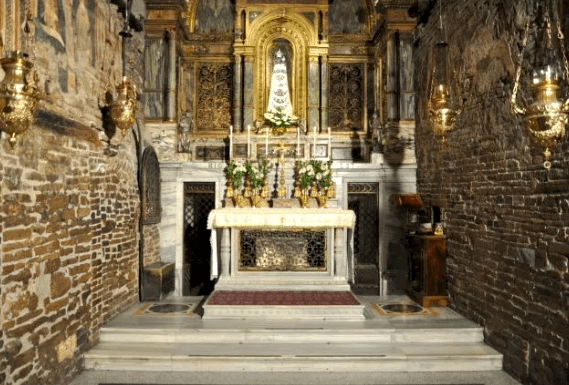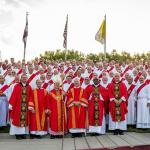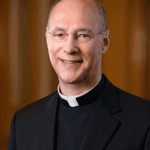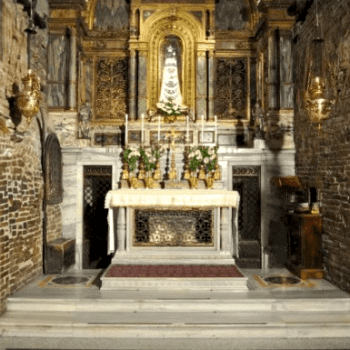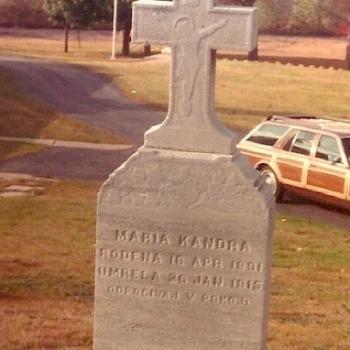Imagine for a moment the map of Italy.
On the back of “the boot,” along the Adriatic Sea, you will find one of the more unusual shrines in all of Europe.
It is in the town of Loreto. At the heart of the town, here’s a huge basilica. Inside of it is a humble stone house. The house is now a chapel. A number of years ago, before I was ordained, I had the privilege of serving Mass there.
But it is unlike any other chapel in the world. It goes to the very heart of our faith.
Church tradition tells us that this was the house of the Holy Family in Nazareth.
While there is some debate about how the house arrived in Loreto, ancient tradition holds that it was brought from Nazareth to Italy by angels. In fact: research has found that the stone and mortar are made from material you find only in the Middle East — not Italy.
Countless pilgrims have been coming to this shrine for centuries. If they pause to read the words engraved above the altar, they will confront part of the mystery that makes this feast we are celebrating today so meaningful and so wondrous.
The words in Latin say: Hic Verbum caro factum est.
“Here, the word became flesh.”
Within those walls, God entered human history.
This is where it happened.
A few years ago, when he visited the house of Loreto, Pope Francis acknowledged the significance not only of the house, but of the young woman who lived there.
At the Incarnation, he said, Mary herself became “a living house for the Lord.”
She was the one whom God chose as his first home on earth.
And we recall today how God himself has honored that “living house.” At the end of her earthly life, she was assumed into heaven, body and soul, where she watches over us, weeps with us, prays with us, hopes with us — our heavenly mother, “the holy queen enthroned above.”
Today, this beautiful Gospel from Luke we just heard takes us not to the end of Mary’s life, but to a moment near the beginning. It tells us how her journey began, and gives us another glimpse of her — a woman of fierce poetry and prayer, whose great canticle, the Magnificat, is threaded with some of the most beautiful language in all of scripture, using references from the Old Testament to help proclaim a new testament, a story of triumph and mercy and hope.
Here, we see that Mary is not just a figure of obedience — but also of tenacity and courage.
The very first words of this Gospel, in fact, remind us that Mary was a young woman on a mission: “Mary set out.” She was a teenager, probably no more than 14 or 15 years old. But she knew what she had to do.
And from that moment on, she never stopped.
She traveled to the hill country, gave birth in a stable, fled to Egypt, sought her missing son in the crowded streets and alleyways of Jerusalem.
Decades later, she stood by after everyone else had run away, and watched that boy, grown into a man, suffer an excruciating and humiliating death.
And it all began with an act of trust, hearing God’s astonishing plan for her life, and then saying, simply, “Yes.”
I am the handmaid of the Lord.
Twenty centuries later, she remains the model for us all: the one who heard the words, “Hail, Mary” and in one shattering moment, changed history.
With that, the Word became flesh.
Hic Verbum caro factum est.
And nothing has ever been the same.
In that humble house in Loreto, Mary, the living house, gave God his first home on earth. And for that, she was rewarded with an eternal home in heaven.
This feast reassures us: that eternal home awaits us all. The Assumption echoes the Resurrection with this simple, hope-filled message: Death doesn’t have the final word.
“God has come to the help of his servant Israel…he has remembered his promise of mercy.”
As we receive Jesus this morning in the Eucharist, we remember the one who received him first, Mary — the one who first made a home for him, becoming a “living house for the Lord,” the one who continues to show each of us how to welcome Christ and how to follow him and how we ourselves can make a home for him
Like Mary, we do it with trust. With faith. With courage. With love. With prayer. And with hope.
Hope in God’s “promise of mercy,” and hope in another home, another house, for all eternity.

